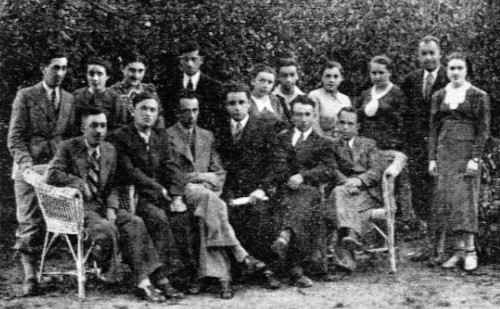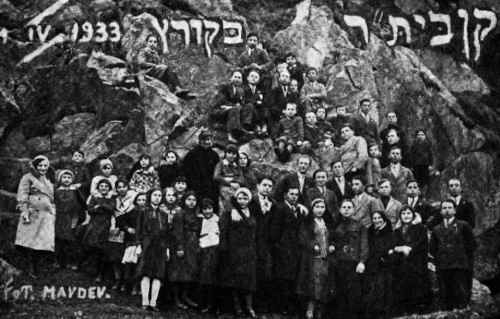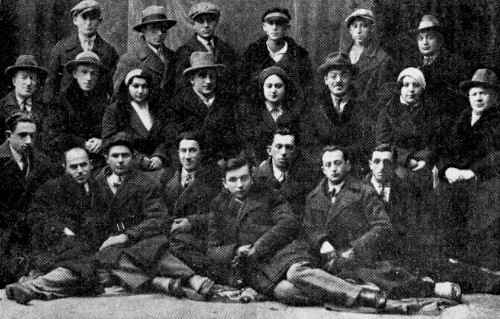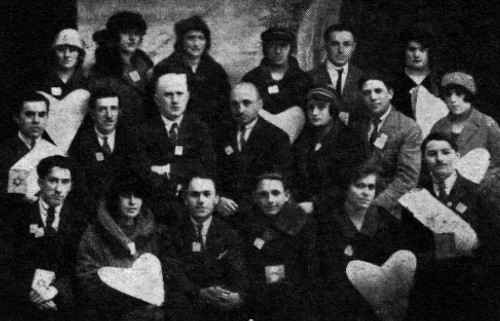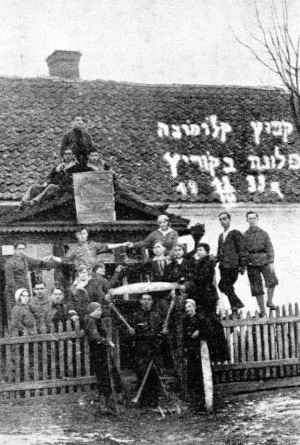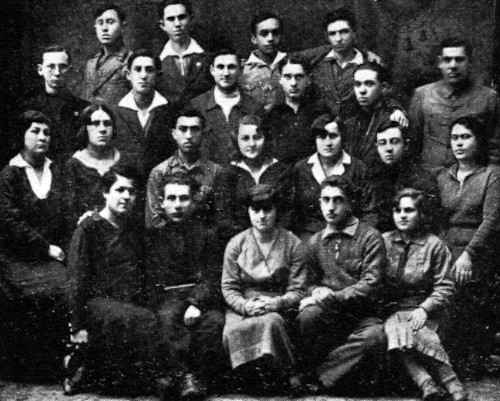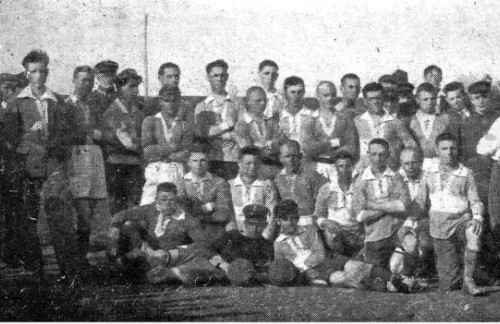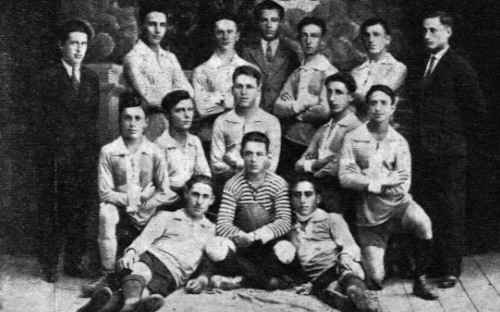[Page 246]
The Revisionist Movement in Korets
by Avraham Singerman
Translated by Monica Devens
The Revisionist Movement arose during the twenties under the leadership and inspiration of the renowned Zionist leader, Zev Jabotinsky z”l, and passed the national and economic activities of the official Zionist leadership under the rod of criticism. Revisionism claimed a complete change of values in the understanding of the Zionist idea and in fulfilling it.
This movement included a great many adults and youths in all of the diaspora and it had a particular stronghold in Poland's 3 million Jews, in whom the Zionist idea had sunk deep roots.
The Revisionist Movement included, at its center, the Beitar youth federation - named after Beitar, the last fortress of Bar-Kochba who led the revolt against the Romans, and also after our contemporary hero, Yosef Trumpeldor z”l (the acronym, Beitar, was Brit Yosef TrumpeldoR) [=the covenant of Yosef Trumpeldor].
Jabotinsky's doctrine came to Korets in 1928. Its first proponents were:
|
|
Beitar and Tzohar [=Revisionist Zionist party] Activists in Korets in the Latter Part of 1937
Standing from right to left: 1) Chana Segal, 2) Chaim-Hersch Ferchik, 3) Rachel Kuralnichik, 4) Breindel Vidro, 5) Dov Neiterman, 6) Beila Ronis, 7) Moshe Firkes, 8) Chava Firkes, 9) Nesia Rachaman, 10) Reuven Feinert
Sitting from right to left: 1) Dov Shamban (a member from the core command), 2) Yaakov Stamer (a member from the core command), 3) Nachum Zafran (a member from the core command), 4) Aharon Tzikman, 5) Avraham Singerman (a member from the core command), 6) Grisha Weisbrod |
[Page 247]
|
|
| The Beitar Core Group in Korets IV 1933 |
[Page 248]
Shmuel Ginsburg, Moshe Glis, Aharon Tzikman, and Shmuel Kliefeld. They established the Beitar core group in our city and constituted its first headquarters. Young people congregated around them, some who had been organized in Zionist youth movements and left their ranks disappointed and some who had not been organized in any movement.
The core group began its activities with a few people, but with the rise in Zionist suspense at the end of the thirties, the number of members of Beitar and Tzohar rose throughout Poland, and this increase was reflected in Korets also. The core began to take on the shape of a popular movement, the number of members of Beitar reaching 100, the Tzohar branch counting 50 people, and several hundred supporters joining them.
The activities of the Revisionist Movement consisted of activities of culture and education, which were held through the clubhouse of the Beitar core group and the Tzohar branch, and activities of publicity throughout the entire Jewish population. The activities at the clubhouse consisted of lectures, public readings, ideological arguments, literary events, wall posters, and communal singing. The activities outside of the clubhouse consisted in organizing public publicity lectures in synagogues and communal halls, arranging parties, participating in memorials in memory of Zionist leaders, donating to the Zionist funds, and organizing appearances in demonstrations and marches that were arranged by the Jewish community together with the local authorities.
The frequent visits of lecturers and speakers from the central authorities of the movement influenced the growth and development of the Revisionist movement in Korets quite considerably. These came, most of the time, following an invitation from the Tzohar branch in Korets. I remember the visits and the lectures of Dr. Lipman, Dr. Shimshon Unichman (today, a member of the “Knesset”), Yisrael Shochet, S. Rozen, the teacher, Yaakov Nordman, Eliezer Shostak (today, a member of the “Knesset”), and others.
These lecturers came principally before the elections to the Zionist Congress or at other opportunities and advocated at public meetings with many participants on behalf of the Revisionist idea. Nevertheless, we did not base our hope on external forces alone. In the branch of the Revisionist movement in our city were outstanding intellectual forces who were very good at explaining the Revisionist idea in public. Among these, the name of the teacher, Yosef Strassburg (worked over the last years as a prosecuting attorney), and Nachum Zafran, who over several years stood at the head of the Korets core group, are remembered.
More than any other Zionist youth movement, Beitar strongly emphasized military training for its students. Beitar did not share the governmental doctrine of Lilienblum, that we would conquer the land of Israel with “another goat and another dunam.” Its opinion was that we would
[Page 249]
conquer our land with fire and sword. That was, perhaps, the dividing line between Jabotinsky youth and the other camp of Zionist youth.
To this end, Aryeh Kutscher and Yehuda Kaplan, who excited the members of Beitar over the idea of military training, visited the core group many times. These guides, not residents of the place, were students of the military training course set up in Warsaw under the auspices of Beitar and the direction of Yirmiyahu Halperin, who gained a reputation as an exemplary teacher for the development of physical strength and the acquisition of military knowledge among Jewish youth.
Two members of the Beitar core group in Korets, Yosef Zimmerman and Avraham Singerman, traveled to Rovno [=Rivne] and Dubno to participate in special army courses for sergeants, which were established there under the auspices of the Beitar leadership, and afterwards returned to Korets and taught the principles of fencing to other members of Beitar.
The development of the Beitar core group and the Tzohar branch in Korets depended on the organizational-intellectual level of those who stood at their head. During the years that there were leaders and activists who possessed exceptional organizational and spiritual ability - the influence of the movement was well felt in the city. However, due to the nature of the movement, which required individual fulfillment, the Beitar core group was perpetually in a fluctuation of rise and fall. The members of the core group leadership changed from time to time since not everyone remained living in Korets for a long time. Some of them went to training groups in Klosova [=Klesiv], Kostopil, and Rokytne and some of them wandered around to places of education. Among those who went for training were: Shmuel Ginsburg, Moshe Glis, Yosef Zimmerman, Moshe (Zaydl) Wachbroit, Gorenstein, and others. Among those who went to places of education - to Rovno [=Rivne], Vilna, Warsaw, and the Hebrew University in Jerusalem - were: Nachum Zafran, Dov Gutnik, and Avraham Singerman. However, even with the continuing departure of activist leaders - faithful activists and leaders remained in Korets, among whom the names I remember are Yaakov Stamer, Dov Shamban, the brothers Dov (Borya) and Moshe Neiterman, Ferchik, Gedaliah Donder, Reuven Fingeret, Breindel Katz, Sarah Brautman, and Mendel Balaj.
In addition to these, among the activists I remember were also the names of other Beitar members, like: Falik Rozenblat, Chava Forshpan, Beila Yaronsky, Moshes Breindes, Zvi Koretsky, Yaakov Zafran, Aharon Tzikman, Moshe Singerman, Yehuda-Meir Schorin, Leibl Glis, Yona Segal, Barak and Miriam Firkes.
Among the important events that took place in the Revisionist movement in our city that are fixed in my memory was the regional conference of the Beitar movement in Rovno [=Rivne], which gathered on the eve of the 18th Zionist Congress in the summer of 1933. Thousands of young people came to the conference from all the cities
[Page 250]
and towns in the region of Volhynia. Most of the members of the core group of Beitar in Korets traveled to this conference, too. This journey took an entire night. We rented carts harnessed to horses, with about 20 Beitarniks sitting in each one, and even though we were cramped and squashed - no one said the place was too tight for him because it was like the trip of Hasidim to their Rebbe, because at this same conference Zev Jabotinsky appeared with one of his great, powerfully expressed speeches. We passed that night with singing and fun and the journey was miraculously short for us …
A second event that I remember well was the marching of Beitar members in the parade of May 3rd - Polish Independence Day - in 1934.
The members of the core group, of whom the large majority came from poor families, collected penny by penny and bought together a large quantity of fabric, gave it to a tailor who sewed from it the official uniform of Beitar. The hats, which were part of the uniform, were ordered from a milliner in Rovno [=Rivne].
With identical outfits and properly practiced marching, the Beitarniks marched and at their head was Nachum Zafran - the commander and Gedaliah Donder carrying our national flag in the streets of the city and made an encouraging impression, not only on the Jewish population, but also on the Christian residents - something which was praised by the local authorities.
The activities of the Revisionist movement ended with the conquering of the city by the Russian armies in the latter part of 1939. A small number of Beitarniks and Tzoharniks emigrated to Israel before and after the Holocaust. A few remain scattered in Russia and Poland. However, the large majority, like all the Jews of our city, gave up their souls for the sanctification of the Name. May their memory be for a blessing!
* * *
[Page 251]
KKL and the Zionist Movement Activists in Korets
by Avraham Shilon (Gilman)
Translated by Monica Devens
The Keren Kayemet Le-Yisrael [=Jewish National Fund] in Korets, of which I had the honor of serving as secretary, in a certain period was known and popular in the city and encompassed all the classes and political streams, from left to right up to the religious Zionist stream; from the young to the elderly in the community, from the simple Jew to the working and free intelligentsia. Activity was carried out through volunteers, with no expenses, and at times even small expenses were covered by the activist members themselves. This volunteerism was one of the important factors in the rising importance of the fund and assuring the success of its widespread activities in this period.
One cannot summarize the activities of the Keren Kayemet without bringing to mind the wonderful band of dear members who gave the best of their time, their energy, and their talents in great respect, really, to these activities.
The first chosen leader in Korets was our member, Zelig Mosman, who served in this capacity for several years before he emigrated to Israel. After him, the member, Herzl Yucht, occupied this position. The third, who loaded burdens on his shoulders, was the member, Herzl Zilberman, who was one of the delightful figures, a symbol of simplicity, friendship, and Zionist enthusiasm. He was a modest young man, one of the 35 Tzaddikim of Zionism, shy, but involved in the life of the public, which meant that the Keren Kayemet was, in his eyes, a sort of “And I set the Lord before me always…” [=Psalm 16:8] morning and night, at home, in the street, and in the synagogue, he guided the activities of the Keren Kayemet. With his activism, he served as a symbol to other activists and involved everyone in its all-encompassing activities. He was really “meshugge” for it and his face lit up with joy when he saw the group of activists growing day by day. He gathered the best of the youth and the people in the city around him. The period of his tenure is thought of as a fruitful period and full of the work of the Keren Kayemet in our city.
The treasurer of the Keren Kayemet during all the years was Dr. Yaakov Wallach (living with us in Israel), Jewishly learned, with a Zionist heart, a true and beloved friend to all. He filled his position with honesty and faithfulness over and above the norm. His home was open to every Zionist activist and more than once received an activist for a consultation while a sick person was waiting in his waiting room.
The member, Herzl Yucht z”l, having a pleasant and imposing appearance, fulfilled his task with devotion and great faithfulness. He served as a kind of Zionist ambassador in the city with regards to the authorities. He
[Page 252]
had strolled in the “upper echelon.” He was a well-known and influential man, would remove any mishap coming from the authorities. He had a large part in bringing the intelligentsia into the Zionist camp. He organized the parties and banquets under the auspices of the national funds.
Among the Zionist activists, the member, Yisrael Melamed z”l, claimed an honored place - a member of the “Hitachdut” party and one of its supporting pillars. A Zionist and Socialist, accepted and loved by all the classes. An activist and dedicated heart and soul in all areas of organization and publicity, recruitment and activating members for work. His store was a kind of Zionist “caramel.” You would meet friends there for conversation, you would find newspapers there and written publicity material. It seems to me that the number of activists was greater than the number of customers coming to buy his flour. The friendly and lively atmosphere encouraged you and motivated hyperactivity. As a polite person and concerned about others, he was ready to offer any help that might be requested by a friend.
And his friend in the movement, Aharon Schenker - the party ideologue, with an aristocratic appearance, all of which spoke of honor and courtesy, ready for any call and active in the area of culture and publicity, an excellent speaker and rousing the masses.
Among the socialist activists, the member, Asher Shikher, of the “Z. S. [=Socialist Zionists] -Poale-Tzion” party, stood out - a deep thinker, serious in his ways and deeds, an outstanding member of the Zionist movement in the city, a speaker and a guide and all of him dedicated to guiding the public, who gathered around him the best of the members of the socialist movement in the city.
For sure, the teacher and outstanding educator, Mr. David Solomianik z”l, belonged to the group of Zionist activists, the “abba” [=father] of the youth who studied and were educated within the walls of the “Tarbut” school, for whom the deceased served as a teacher and pedagogical leader. He dedicated the better part of his time to the youth who loved him dearly and followed his example out of courtesy and unending admiration. A large part for him was motivating the youth to organize in a movement framework, a place where he saw the continuation of the youth's education outside the school walls. I recall the literary clubs he organized from among the graduating classes of the youth: the public hearings he led on Zionist subjects and future paths for the youth, and the youth parties he arranged in the name of keeping a live connection among the young. A special identifying sign existed for the graduates of the school: the “ayin” [=Hebrew letter] on a suit lapel or shirt told you that you had to speak Hebrew with this graduate. This was a man who stood at the center of the cultural activity in the city and was the help of the teachers and party activists and youth in the city.
And a complete and long line of leaders and guides of the movement youth in the city
[Page 253]
|
|
The “Keren Kayemet Le-Yisrael” Committee in Korets, with the participation of Dr. A. Bernstein
Standing from right to left: 1) Herzl Yucht. 2) Mordechai Turchinskij, 3) Noach Dagoni (Hecht), 4) Avraham Shilon, 5) Yitzhak Wilner, 6) Leibish Prikzania
Sitting from right to left: 1) Dr. Yaakov Wallach, 2) Leah Konofit, 3) David Solomianik, 4) , 5) Dr. A. Bernstein, 6) Sonya Tsipinskiy, 7) Herzl Zilberman, 8) Asher Shikher
Sitting in a third row from right to left: 1) Noach Chirik, 2) Yosef Kligerman, 3) Yaakov Rozenszturm, 4) , 5) Shlomo Shikher, 6) Meir Litvak, 7) Zelig Mosman, 8) Aryeh Zabodnik |
[Page 254]
who were represented in all the various committees worked and put to work hundreds of young members, it is worth mentioning only some of them who stood at the center of the action: Zelig Mosman, Yosef Kligerman, Faiga Zabodnik, Dov Bernstein, Chaim Smolier, Moshe Smolier, Yosef Wachbroit, Yitzhak Wilner, Sarah Singerman, Eliezer Basyuk, Yaakov Rubin, Mumah Mabler, Yaakov Rozenszturm, Tusya Solomianik, Munya Góralnik, Freyda Tsmolker, Avraham Gilgon, Noach Dagoni (Hecht), Mordechai Turchinskij, and last but not least - Noach Chirik, the simple young man, who served as a sort of connector between the chosen leader and the activists.
They gave the best of their time to KKL and served as the leverage for instilling the Zionist idea in every Jewish home and student and graduate in the city.
KKL worked in various directions: 1) the Blue Box [=collection box for donations]. 2) KKL stamps. 3) Collecting donations at parties. 4) Logging. 5) Movie Days. 6) Sending “Happy New Year” greetings. 7) Vows and “Yizkor” [=remembrances] 8) Schools and stamps, etc.
There was no Jewish household in which you didn't find the blue box on display in the entrance and members of the household and guests would drop small coins into it, which, during the month, came up to some reasonable sums. The youth movements would send their members to empty the boxes and give a suitable receipt for the amount, which was then transmitted to the treasurer, Dr. Wallach.
A lovely custom that became tradition was added to the month of Elul in greeting the new year and it was - sending Rosh ha-Shanah greetings. All the work connected to sending the sender's greetings to their recipients were carried out by the youth according to all the official postal regulations (of course, in an illegal manner because this was against the official postal law). A KKL stamp and the seal of the youth movement that was carrying out the delivery would be affixed to the envelope. The youth would sort the envelopes by street and on the same day everyone would received the envelope at their home (faster than that which came by official mail), the money for the stamps being turned over to the treasurer of KKL.
It was customary that every party or friends-and-family affair was announced to the KKL committee and they would send a pair of donors with a special paper on which all the donations of the participants were listed.
Planting trees in the KKL forest was customary at every family party in honor of a birth or a wedding and also a sign of esteem for a friend. In return for planting trees, the celebrant would receive a lovely certificate that would decorate his house.
Often, they would arrange a movie day. When you went out in the morning to the streets of the city, you would meet pairs of youth competing among themselves over how big a collection of coins was in their boxes and suitable certificates were given to the outstanding ones. The last report on the activities of KKL that we have is from 1935. In that year, there were collected in Korets
[Page 255]
1080.74 zlotys. The expenses came, in total, to 53 zlotys, which proves the spirit of volunteerism of the activists of KKL.
These activities, more than they served as a source of material income, were a valuable educational cause that constituted an outlet for the great energy of the enthusiastic and lively youth of the city.
|
|
Activists of the Movie Day on Behalf of KKL
Standing from right to left: 1) , 2) Chaim Smolier, 3) Mumah Mabler, 4) Chana Herschenhorn, 5) Roza Rabinowitz (Shochen), 6) Yatum
Sitting from right to left: 1) Teibel Reizelman, 2) Simcha Baraz, 3) Sheva Rozenblat, 4) Herzl Yucht, 5) Dr. Yaakov Wallach, 6) Asher Shikher, 7) Moshe Charbash
Sitting below from right to left: 1) Perlman, 2) Batya Gilman, 3) Moshe Smolier, 4) Zelig Mosman, 5) Chaya Baraz, 6) Shlomo Shikher |
[Page 256]
The Training Company in Korets
by Bat-Zion Shoshani (Turtcheniok)
Translated by Monica Devens
In August 1932, I arrived in Korets for training. A “work conquest” company of Kibbutz Klosova [=Klesiv], numbering about 10 members, men and women, who had come from different places, was there. In about two months, our number rose to 25 people.
We started looking for work so that we could support ourselves. Most of the members of the company were between the ages of 25 and 30, though some of them, me included, were only 17. We had never tried physical work, nevertheless a strong desire beat within us to prove ourselves as workers and we made an effort to take on all kinds of work.
Our first work place was the sugar factory. By chance, they were missing a few workers at the time and so they accepted us, having no choice. We worked at taking out the beet roots and piling them on carts. Six members were employed to do this work for 3 weeks and we earned 1.20 zlotys per day. The other members were busy looking for work. They roamed around the city with saws and axes in their hands and tried to compete with the “goyim.”
The girls would saw the trees and arrange them, and the boys would cut them into pieces.
Nevertheless, our bad luck was that “sympathetic Jews” became concerned for us, that Jews would be humiliated doing all sorts of hard and back-breaking work, and because of this, they refused to employ us in their houses or their businesses.
Passover was coming near and our good Jews came to the conclusion that, if there might be, God forbid, a disruption of the correctness of the holiday, there was a need to allow the employment of Jewish girls and boys in all kinds of cleaning tasks.
Even though Korets was a small city, there were more than 20 Batei Midrash [=places of Torah study] there. They employed us to clean the synagogues and we were all busy with this holy work. There were also some “pioneering people” among the housewives of Korets who took us to clean their houses and do their laundry.
They were surprised when we refused to eat at their table and not even to drink a glass of tea. They implored us all day long and we kept to ourselves: we had our “own” food. A very strong will was required to not be tempted because we were very hungry. Our food for the entire day was made up of potato soup, a glass of bitter chicory, and a dry piece of bread.
[Page 257]
More than once I saw tears in the eyes of the women when we refused to eat at their table. But there was strong internal discipline and we conquered our desire.
Over time, I got to know many residents of the city. We began to be guides at the “He-Halutz Ha-Tza'ir” branch and every evening, the training company house was full of many guests. Avraham Hok was a routine guest with us. In our house, despite the poverty and the crowding, there was always happiness. We sang and danced until late at night and didn't feel tired.
On Friday nights, we didn't close our eyes. After all, tomorrow was a day of rest. And so we danced all
|
|
| Kibbutz Klosova [=Klesiv] Company in Korets |
[Page 258]
night, sang, and also read together. On Shabbat, we hiked around every corner of the city and outside it. We would come to the sugar factory. It was forbidden to go beyond it because this was the border. For hours we stood and looked at the Russian sentries, at the barracks which hummed with many troops, and at the monasteries.
The holidays passed and with them, the glory days disappeared. The synagogues and Jewish houses in Korets were clean. They refused to accept us to do laundry for “humane” reasons and there weren't any trees, either. Hunger and cold began to bother us more and more. We made efforts to get work, but, unfortunately, they were not successful.
One evening, Avraham Hock told me that there was a very active drama club in Korets that put on plays all during the winter, but it was suffering from a lack of artistic resources. He suggested to me that I join the club and I would be paid. I refused to even listen to this suggestion because it looked to remove me from my faith and my beliefs, but the opinion of the company members was different: they said that this is work like all other work and there was no reason to be embarrassed by it.
At the time, there were two drama clubs in Korets or, to be more precise, two “prima donnas.” One was young and pleasant, and the other older. Apparently, they had completely different world views and so they did not appear on the same stage, rather each built her own stage. The first presented a play called “The Forced Wedding” and the other - “The Holy Sabbath in the Forest.”
It was hard for me to participate in these types of plays and to fill an extremely “unethical” role. I was young and shy, but I didn't have another choice. A man has to eat and “a man will commit a crime for a piece of bread” and a woman will, too.
Winter was at its height and a deep cold permeated our house. We had no wood for heating. In the morning, we would move about the city and afterwards, we would go to the synagogue. It was, at least, warm there and the meeting was pleasant. The yeshiva boys, who prayed and studied, were in the synagogue. Each one stood next to a lectern (shtender), prayed, and slowly moved forward until they encountered us. Then a pleasant conversation would begin between us. They liked us and we hung out through the entire winter at the synagogue. At evening time, we would return tired and hungry to our houses.
Our economic situation was very dire. Bread became a rare visitor in our houses. At the beginning, we ate one bread per day, then one in two days, and the situation got so bad that we ate bread only once a week.
We started to explain to the Jews of Korets that, if they did not give us work and continued to “pity”
[Page 259]
us - we were likely to die of hunger. One day, they requested one member to do laundry work. I went and, when I came to the place, a pleasant woman, around 40, opened the door and asked me what I wanted. I said that I had been sent from the kibbutz to do their laundry. She looked me up and down and down and up and said, entirely agitated: “May God protect me! Such a young and noble child will do laundry for me? This can't be!” I tried to convince her that I was a veteran at the job and had already done similar work in many houses, and if she didn't accept me to work, I wouldn't have any bread to eat. - She answered me: So stay with me all day, you'll get paid for doing nothing, and at the kibbutz, you will tell them that you got your pay for the work that you did. I explained to her that it was not possible to do something like that and a waste of time. I went away and as she opened the door for me, she began to cry and to beg me to stay with her until evening. This was just one incident among many.
Only one of our members had regular work at a flour mill, named Eliezer z”l. He died of an illness in about a year. This member worked very hard from sunrise to sunset and supported us all.
The terrible nutrition and unhygienic conditions left their marks on us. Many members had skin diseases and sores. They called it “tagus.” There was no money to pay a doctor or pharmacy. We got a sulfur ointment for free that gave the entire house a bad odor. Despite our difficult situation, we were in a good mood.
There were times when we had not a slice of bread for two weeks. We survived on potatoes and chicory alone. And now it was nearing Purim and I got a package from home. Getting a package was considered the greatest crime and so, there was a meeting and it was decided to send this present back to my parents. Even so, we arranged a Purim celebration where everyone danced in a circle around the package. Through the dancing, stringency lessened and it was decided to open the package and see what was in it. We found cakes, soap, and socks for all the members of the company, cigarettes, and 10 zlotys. I decided to eat the cakes because, after all, it was Purim, that we would take the money as a loan to buy flour, and return the rest. As they say, “there's no return from the cemetery,” so we, too, did not return anything and the matter was forgotten.
In the meantime, the Jews of the city woke up and came to our aid under the influence of “He-Halutz” [=a Zionist youth movement] and “He-Halutz Ha-Tza'ir,” who were routine guests at our house. A committee was organized for the kibbutz. A doctor, a teacher from the “Tarbut” school, and a few other people participated in the committee. They visited us, got interested in us, but they weren't able to help much since there was no work.
[Page 260]
After many discussions at the office of “He-Halutz,” they came to the view that we had no possibility of continuing to exist in Korets and it was decided to scatter us among all sorts of training groups. We broke the kibbutz apart, the tools were transferred to Klosova [=Klesiv], we paid our debts, and we began to part from the Jews of the city.
The last Shabbat was dedicated to a hike in the area with members of “He-Halutz” and “He-Halutz Ha-Tza'ir.” In the evening, we arranged a going away party for the members of the movement and supporters. In great sadness, we parted from all of them. In the morning, we hired a cart, piled our various personal belongings on it, and went out to Rovno [=Rivne], from where we scattered to all the four winds of Volhynia.
Korets and its people remain in my memory as a lovely and important period in my life. I was happy to get to know this city and its people, its lovely and lively youth, of whom not many remain alive.
May their memory be blessed.
|
|
The Training Company in Korets
First row standing from right to left: 1) Ross, 2) Dov, 3) Ross, 4)
Second row standing: 1) Baruch z”l, 2) , 3) , 4) Katriel, 5) Noach Dagoni, 6) Walfish
Third row sitting: 1) Dvora Finklestein, 2) Moshe Sasover, 3) Dina Sasover, 4) Bat-Zion Shoshani (Turtcheniok), 5) , 6) Mindel, 7) Shoshana
Fourth row sitting: 1) Slovka, 2) , 3) Sarah (from Hoshcha), 4) , 5) Leah Blich/Vabsky |
[Page 261]
The Sports Movement in Korets
by Aizik Kesselman
Translated by Monica Devens
Jewish sport was born in Korets through the “TAZ” [=daily newspaper] company. In 1926, the chairman of “TAZ,” Dr. Zeitlin, invited Asher Kliefeld, Shmuel Perlman z”l (tragically killed in the riots that broke out in Holon in 1944), and I, and suggested that we take upon ourselves the initiative to develop all kinds of sports among the Jewish youth of Korets. To this end, the company put their large hall at our disposal and all the expenses would be on their account.
We accepted the suggestion enthusiastically and began to organize an apolitical youth organization for sports activities. We gathered various young people between the ages of 10 and 22 and we called ourselves the “Sports Association through ‘TAZ.’” Already at the beginning 120 young people were registered. Dr. Zeitlin and Dr. Hirshenhorn examined the children and youth with great strictness and anyone whose health was suspected of not being in order - was disqualified. These two doctors accompanied the sports activities as a regular matter. During a soccer match or any other sporting event, they remained until the end in order to give medical aid when needed.
In 1929, we stopped being on our own and accepted the name “Maccabee.” The founding committee
|
|
| The “Maccabee” Soccer Team in Korets |
[Page 262]
|
|
The “Maccabee” Soccer Team
Standing from right to left: 1) Shmuel Perlman, 2) Michal Kozoshman, 3) Asher Kliefeld, 4) Yaakov Rozendorn, 5) Lyuba Burstein, 6) , 7) Shmuel Kliefeld
Second row from right to left: 1) Yitzhak Baraz, 2) Aizik Kesselman, 3) Moshe Singerman, 4) Shmuel Ginsburg, 5) Mitzik Schorin
Third row from right to left: 1) Yitzhak Schneider, 2) Moshe Ehrlich, 3) Reuven Kipret |
was: Shmuel Perlman, Aizik Kesselman, Asher Kliefeld, Dov Baru, Avraham Gechman, and Reuven Kipret.
In the beginning, we didn't have our own coaches and trainers and we had to train on the outside. In 1927, we brought in the first instructor, Yitzhak Kalrics, from “Ha-Hashmona'i” in Rovno [=Rivne]. He was a very talented trainer and sports guide and he approached the task with great energy. The “TAZ” company acquired for us all the necessary equipment. In a short time, we grew in number and were very successful in developing sport. We began to appear in public in various games and our appearances earned us honors with the Polish authorities, which the non-Jewish sports associations did not earn.
Within a short time, we organized a soccer team, which was the strongest in the city. We beat the Polish team, K. A. P. (The Border Protection Corps), and also “Sokol.”
Drunk on these wins, we went to test ourselves with the acclaimed soccer team,
[Page 263]
“Ha-Hashmona'i” in Rovno [=Rivne]. In truth, we suffered a terrible loss, but simply the fact that this team answered us was a kind of mark of our great achievements in soccer.
The official authorities esteemed “Maccabee” greatly. On May 3, Poland's national holiday, we were invited to participate in the festivities and thus we appeared at every Polish holiday.
Despite our successes, we were still in need of leaders from the outside and we invited a new trainer, Yitzhak Gorenstein, he, too, coming from “Ha-Hashmona'i” in Rovno [=Rivne]. When he left us, the period of the “Internal Registry” began - that Kliefeld and myself served as leaders.
We tried to bring the matter of Korets sports to nearby cities and towns. We played in Rovno [=Rivne], Hoshcha, Berezne, and Sarani. Similarly, we competed against the Polish teams in those places. We always won in Hoshcha, in Berezne and Rovno [=Rivne] we lost, and in Sarani we won.
After I emigrated to Israel, as I was told, sports in Korets continued to develop and included more broad clubs, until the flood came and wiped it all out.
[Page 264]
[Blank]
This material is made available by JewishGen, Inc.
and the Yizkor Book Project for the purpose of
fulfilling our
mission of disseminating information about the Holocaust and
destroyed Jewish communities.
This material may not be copied,
sold or bartered without JewishGen, Inc.'s permission. Rights may be
reserved by the copyright holder.
JewishGen, Inc. makes no representations regarding the accuracy of
the translation. The reader may wish to refer to the original material
for verification.
JewishGen is not responsible for inaccuracies or omissions in the original work and cannot rewrite or edit the text to correct inaccuracies and/or omissions.
Our mission is to produce a translation of the original work and we cannot verify the accuracy of statements or alter facts cited.
 Korets, Ukraine
Korets, Ukraine
 Yizkor Book Project
Yizkor Book Project
 JewishGen Home Page
JewishGen Home Page
Yizkor Book Director, Lance Ackerfeld
This web page created by Jason Hallgarten
Copyright © 1999-2025 by JewishGen, Inc.
Updated 11 Dec 2024 by JH
